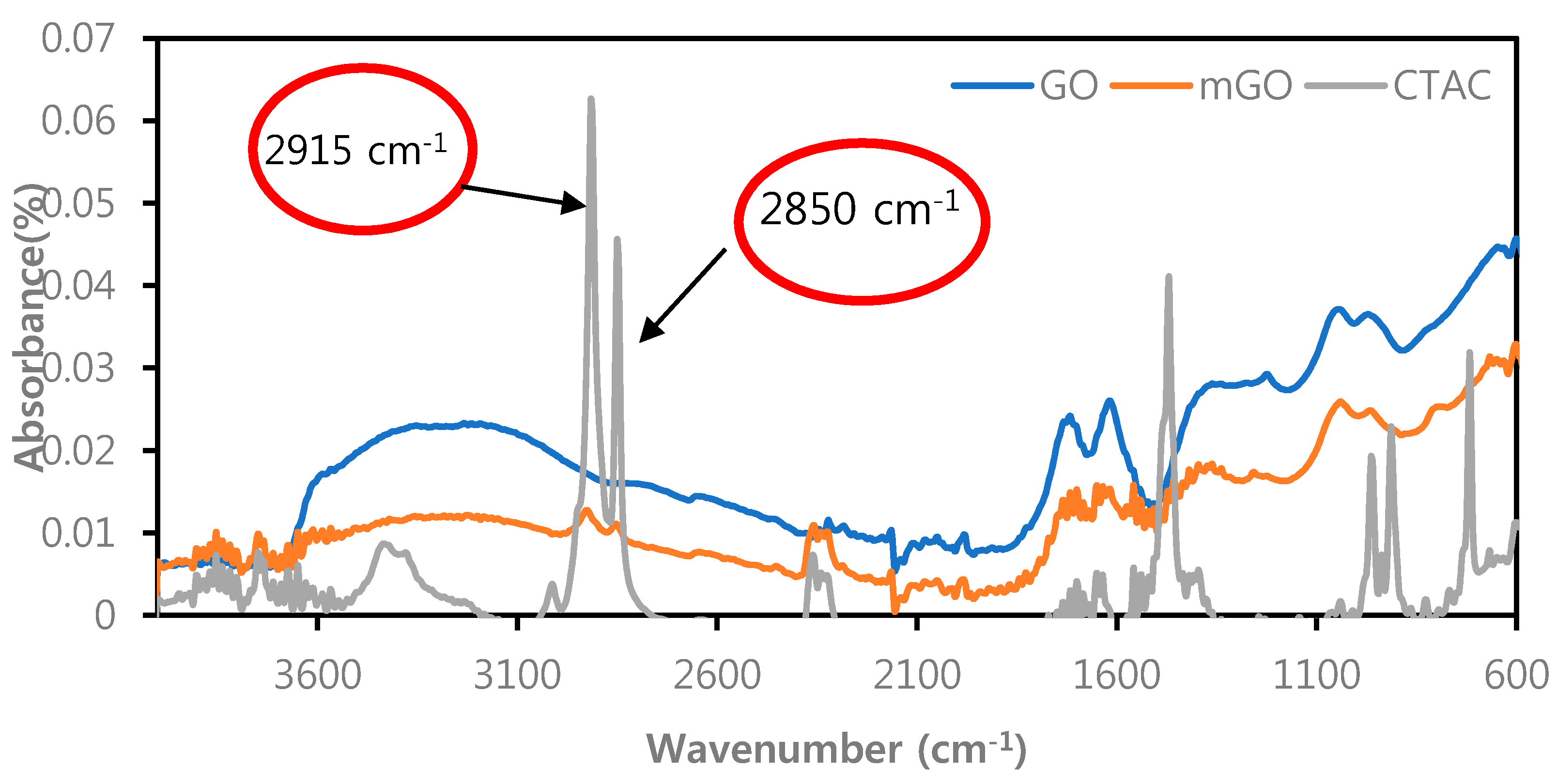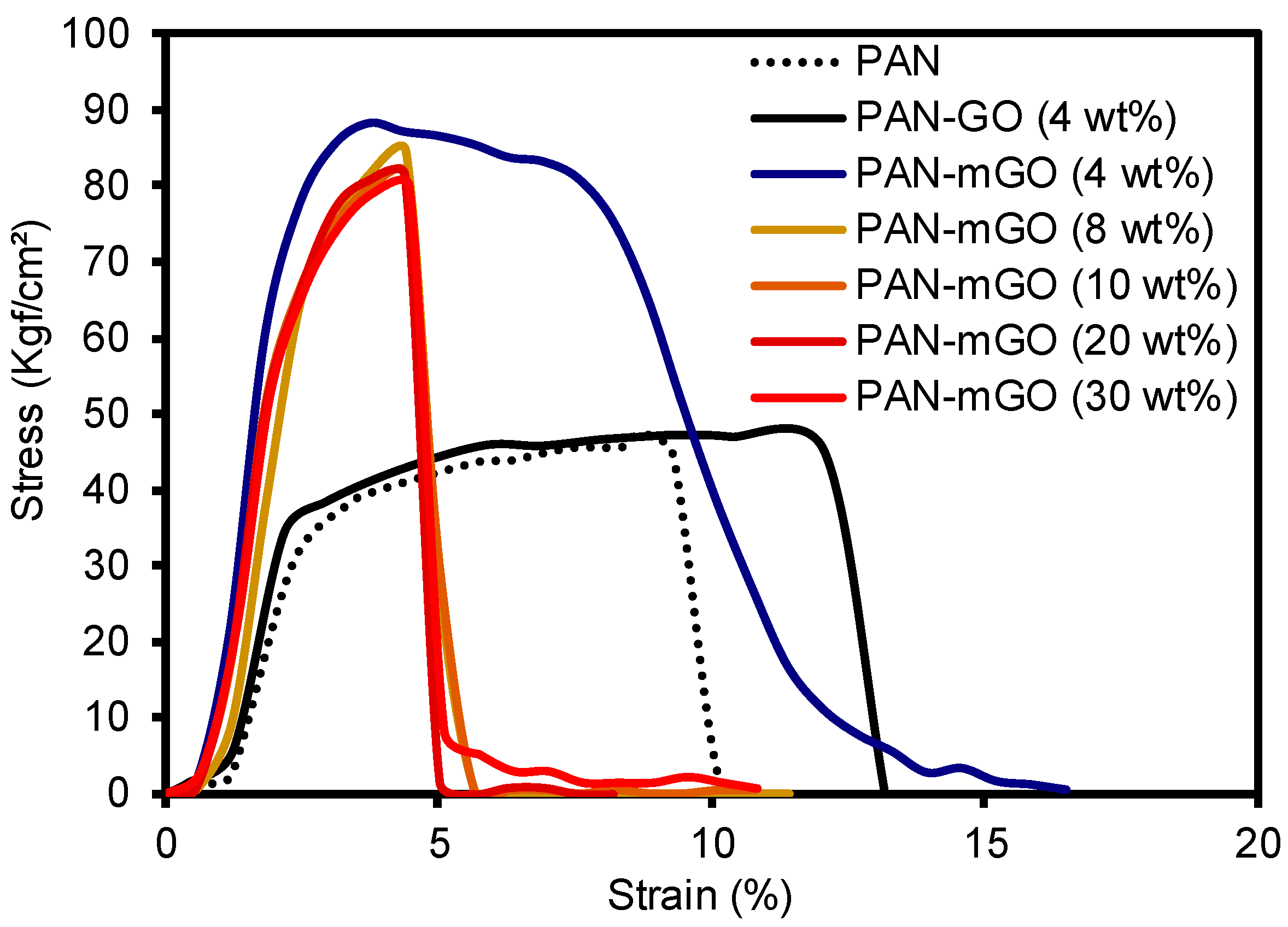Highly Controlled Integration of Graphene Oxide into PAN Nanofiber Membranes
Abstract
1. Introduction
2. Materials and Methods
2.1. Materials
2.2. Preparation of Bare PAN and PAN/GO Nanofiber Membranes via Electrospinning
2.3. Characterization of PAN-GO Composite Membranes
3. Results and Discussion
4. Conclusions
Author Contributions
Funding
Conflicts of Interest
References
- Lee, J.; Yoon, J.; Kim, J.-H.; Lee, T.; Byun, H. Electrospun PAN–GO composite nanofibers as water purification membranes. J. Appl. Polym. Sci. 2018, 135, 45858. [Google Scholar] [CrossRef]
- Yan, T.; Pan, Z. High conductivity electrospun carbon/graphene composite nanofiber yarns. Polym. Eng. Sci. 2018, 58, 903–912. [Google Scholar] [CrossRef]
- Sharma, S.K.; Sokhi, S.; Balomajumder, C.; Satapathi, S. Reusable graphene oxide nanofibers for enhanced photocatalytic activity: A detailed mechanistic study. J. Mater. Sci. 2017, 52, 5390–5403. [Google Scholar] [CrossRef]
- Agarwal, S.; Burgard, M.; Greiner, A.; Wendorff, J. Electrospinning—A Practical Guide to Nanofibers; De Gruyter: Berlin, Germany, 2016; pp. 5–10. [Google Scholar]
- Afshari, M. Electrospun Nanofibers, 1st ed.; Woodhead Publishing: Cambridge, UK, 2017; pp. 1–8. [Google Scholar]
- Wang, Q.; Du, Y.; Feng, Q.; Huang, F.; Lu, K.; Liu, J.; Wei, Q. Nanostructures and surface nanomechanical properties of polyacrylonitrile/graphene oxide composite nanofibers by electrospinning. J. Appl. Polym. Sci. 2013, 128, 1152–1157. [Google Scholar] [CrossRef]
- Lee, J. Fabrication of Nanofiber Separator for Water Treatment Using Graphene Oxide and Improvement of Physical Properties of Nanofiber. Master’s Thesis, Keimyung University, Daegu, Korea, 2017; pp. 43–44. [Google Scholar]
- Chen, J.; Yao, B.; Li, C.; Shi, G. An improved Hummers method for eco-friendly synthesis of graphene oxide. Carbon 2013, 64, 225–229. [Google Scholar] [CrossRef]
- Jang, W.; Yun, J.; Byun, H. Preparation of PAN nanofiber composite membrane with Fe3O4 functionalized graphene oxide and its application as a water treatment membrane. Membrane J. 2014, 24, 151–157. [Google Scholar] [CrossRef]
- Hosseini Ravandi, S.A.; Sadrjahani, M. Mechanical and structural characterizations of simultaneously aligned and heat treated PAN nanofibers. J. Appl. Polym. Sci. 2012, 124, 3529–3537. [Google Scholar] [CrossRef]
- Jang, W.; Yun, J.; Jeon, K.; Byun, H. PVdF/graphene oxide hybrid membranes via electrospinning for water treatment applications. RSC Adv. 2015, 5, 46711–46717. [Google Scholar] [CrossRef]
- Huang, X. A facile approach to make high performance nano-fiber reinforced composite separator for lithium ion batteries. J. Power Sources 2016, 323, 17–22. [Google Scholar] [CrossRef]
- Lee, J.; Chae, H.-R.; Won, Y.; Lee, K.; Lee, C.-H.; Kim, I.-C.; Lee, J.-M. Graphene oxide nanoplatelets composite membrane with hydrophilic and antifouling properties for wastewater treatment. J. Membr. Sci. 2013, 448, 223–230. [Google Scholar] [CrossRef]
- Hou, X.; Yang, X.; Zhang, L.; Waclawik, E.; Wu, S. Stretching-induced crystallinity and orientation to improve the mechanical properties of electrospun PAN nanocomposites. Mater. Des. 2010, 31, 1726–1730. [Google Scholar] [CrossRef]
- Bai, Y.; Huang, Z.-H.; Yu, X.-L.; Kang, F. Graphene oxide-embedded porous carbon nanofiber webs by electrospinning for capacitive deionization. Colloids Surf. A 2014, 444, 153–158. [Google Scholar] [CrossRef]



| Sample | Biggest Pore Size (nm) <Bubble Point> | Smallest Pore Size (nm) | Avg. Pore Size (nm) | Thickness (um) | Porosity (%) |
|---|---|---|---|---|---|
| Bare PAN | 664 | 167 | 207 | 80 ± 1 | 54 ± 2 |
| PAN-GO4 | 559 | 311 | 334 | 83 ± 1 | 53 ± 1 |
| PAN-mGO4 | 457 | 223 | 260 | 84 ± 2 | 51 ± 3 |
| PAN-mGO10 | 484 | 251 | 279 | 89 ± 2 | 49 ± 3 |
| PAN-mGO20 | 499 | 279 | 302 | 91 ± 3 | 48 ± 4 |
| PAN-mGO30 | 514 | 310 | 332 | 92 ± 2 | 48 ± 2 |
© 2019 by the authors. Licensee MDPI, Basel, Switzerland. This article is an open access article distributed under the terms and conditions of the Creative Commons Attribution (CC BY) license (http://creativecommons.org/licenses/by/4.0/).
Share and Cite
Hou, J.; Yun, J.; Kim, S.; Byun, H. Highly Controlled Integration of Graphene Oxide into PAN Nanofiber Membranes. Appl. Sci. 2019, 9, 962. https://doi.org/10.3390/app9050962
Hou J, Yun J, Kim S, Byun H. Highly Controlled Integration of Graphene Oxide into PAN Nanofiber Membranes. Applied Sciences. 2019; 9(5):962. https://doi.org/10.3390/app9050962
Chicago/Turabian StyleHou, Jian, Jaehan Yun, Sungyul Kim, and Hongsik Byun. 2019. "Highly Controlled Integration of Graphene Oxide into PAN Nanofiber Membranes" Applied Sciences 9, no. 5: 962. https://doi.org/10.3390/app9050962
APA StyleHou, J., Yun, J., Kim, S., & Byun, H. (2019). Highly Controlled Integration of Graphene Oxide into PAN Nanofiber Membranes. Applied Sciences, 9(5), 962. https://doi.org/10.3390/app9050962






